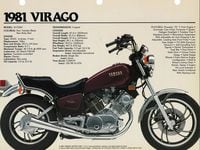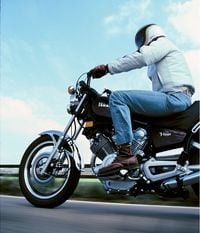"Uh-oh," Yamaha's Ed Burke said to himself. "This isn't good."
Sitting in the audience during Yamaha's 1981-season dealer meeting in the fall of '80, Burke noticed that dealers seemed lukewarm about the all-new V-twin cruiser—Japan's first-ever—that had just been revealed on stage in dramatic fashion. Dealers were ecstatic about the other new bikes introduced that evening—motocrossers, minibikes, and twin-, triple-, and four-cylinder streetbikes. But not the shocking new Vee.
“It was a bit quiet,” Burke says, “and not at all like the last few meetings. Dealers had stood up and cheered when we rolled out a new cruiser. Not this time.”
His gut feeling wasn’t diminished later in the display hall, where examples of the new single-shocked and monocoque-framed Virago sat under bright lights. Dealers were interested and asked questions as they peered at the shaft-driven V-twin. But there wasn’t the visceral excitement he’d seen when Yamaha had rolled out the 650 Special in ’78, or the XS11 Special in ’79, or the black and gold Midnight Specials a year later.
The Virago, of course, wasn’t a Special. It was an all-new design, one built from scratch by Yamaha’s Japan-based designers and engineers, integrating the very latest technology and a thoroughly unusual (indeed, unique) styling footprint. And that, Burke thought, was part of the problem.
Perspective is helpful. The DNA of the Japanese cruiser can be traced primarily to our bicentennial year of 1976, and Kawasaki’s KZ900 LTD—basically a KZ900/Z1 with an extended fork, pullback handlebar, and stepped seat. While a mostly exploratory effort, the bike’s shape and flavor soon began to resonate with boomers, the leading edge of which turned 30 that year.
When Yamaha followed suit in '78 with the 650 Special (a modified version of its Brit-flavored 650 twin) and XS11 Special a year later, the category began to boil. And by the time Jimmy Carter's first term ended, Yamaha found itself with a good-size lineup of popular cruisers in several displacement categories. It also found itself with explosive sales and a leg up on everyone else in what had quickly become the biggest trend in motorcycling.
"We'd seen this coming," Burke remembers. "We'd done a lot of research in the later 1970s, mostly on Japanese boomer customers, but also some with Harley-Davidson buyers. My colleague Dennis Stephani and I found a serious desire for more traditional styling and a more relaxed seating position. And as soon as we gave it to them in twins, triples, and fours, they ate it up. In fact, we did so well we briefly surpassed Honda in sales, all of which led to the destructive Honda/Yamaha 'war.' But that's another story…"
During all this research, and as Yamaha fashioned custom variants of its standard-spec streetbikes to great customer acceptance and big sales numbers, a team of engineers and stylists was at work on a completely different sort of cruiser—one powered by a V-twin. To that point, no Japanese company had built a Vee, at least one in the spirit of traditional American motorcycles. “There was no official stance on this,” Burke says, “just an understanding that no one would do it.”
Labeled "Project 003" internally, the XV750 Virago effort began in early 1978 and was green-lighted ostensibly to help make Yamaha the leader in cruiser-style motorcycles in the US. In fact, what Yamaha was really after was the numero uno position, and with Honda so far ignoring the cruiser market (it didn't get in until 1980), Yamaha saw an opportunity. "We made some huge gains in the late '70s," Burke says. "We were signing up Honda dealerships that had been exclusive for years, our sales were good, and our volume and revenue were at their highest points ever."
Back in Japan, however, the Virago team was having some challenges, struggling to reconcile three very different design directions at once. One camp was the engineers themselves, who were focused on a couple of basic parameters. One was injecting the Virago with as much new-think technology as possible: monoshock suspension, offset cylinders, a new-design frame, etc. The other was the idea that the new bike could not be (or be called) a Harley “copy.”
“They were adamant about that,” Burke remembers, “and it was frustrating for us to communicate that many of those styling elements they were ignoring weren’t owned by Milwaukee. They were American motorcycle and hot-rod design elements from way back. Harley just happened to be the last company standing.”
The second camp was Yamaha’s European product planners, who wanted little to do with a cruiser. Their push was for a sportier model, which would end up being the clubman-esque XV920. Still, the Euros affected the Virago project by pushing technology, which made sense given that Europe was almost exclusively a sport and touring market.
The third camp was Burke's US group, which wanted a V-twin cruiser that fit the traditional styling and seating-position directions dictated by the research they were doing on American customers. Burke and his team felt strongly that this more traditional aesthetic approach would be key to the Virago's success, and the fact that their current roster of Specials was selling well and proving popular with buyers provided some proof of this.
Problem was, the Virago wasn’t following this traditional design and aesthetic theme. As its shape and mechanical underpinnings coalesced during ’79, Burke and his team saw that the bike’s overall look had moved in a more modern direction. This was especially true in back, where the upper wishbone for the monoshock suspension looked out of place to consumers accustomed to seeing twin shocks.
“The ergonomics were pretty good,” Burke says, “but it just didn’t hang together visually, at least relative to what we’d envisioned and fought for. The tank was weird. The lack of shocks was jarring. The swirl-design wheels were really different. And the engine was almost too smooth. Cruiser owners like to feel the machine as much as ride and look at it.
“Basically, [the factory] sacrificed many of the traditional cruiser values American customers actually wanted by going a little overboard with technology. Of course, they’re Japanese motorcycle engineers, and that’s what they do. But in this case they needed to incorporate at least some of what we’d told them and what we’d researched. We argued as much as we could, but in the end we couldn’t make the case. They missed the target, which happens on occasion.”
Most Yamaha dealers felt the same way, which resulted in their "not quite sure what to think of this" attitude at the Virago's launch. Press reaction was generally positive, especially where the Virago's function was concerned. The bike made plenty of usable power, handled and braked well, and was even praised by some editorial go-fast types, Motorcyclist's Ken Vreeke in particular. "I just got back from a three-hour ride on roads where I usually see nothing but imaginary brake markers and apex cones. This time I saw meadows, trees waving the breeze, even a lake I never knew existed. It's not because I'm getting old; it's because the Virago is the embodiment of what the Factory Specials were always meant to be." For Vreeke, the Virago's laid-back styling was ideally matched to an engine in no hurry to get you somewhere.
Still, the bike did not resonate with buyers nearly as well as expected. And with help from an early 1980s recession, retail sales were lackluster through ’81 and ’82. “It took 18 months or so,” Burke remembers, “but we finally convinced [Japan] to rethink the Virago. A key to this turnaround was my association with John Reed, a renowned custom-bike guru from the UK who’d built an ultra-radical custom using a Virago engine that won first prize in a few high-profile custom shows.”
Burke visited Reed several times in his wonderfully quaint shop over the course of 1982 and ’83, and together they built a prototype of the machine Burke’s team had envisioned two years earlier. “Sometimes the Japanese side needed some sort of confirmation about something we were pushing,” Burke remembers, “and I think John gave them that. He had a sort of custom-market credibility I lacked, and once that styling prototype arrived in Japan, they began to see what our team had been pushing all along.”
The prototype the pair developed lacked the finish quality of a production (or truly custom) motorcycle. But its shapes, shocks (!), and aesthetic treatment were a clear departure from the original’s. They pointed the way—Burke hoped—to a machine that would be much more pleasing to American buyers. He just needed Japan to agree to move ahead.
And when they did, a new-generation Virago was given the go-ahead. The original V-twin powerplant was retained with some minor changes, and the new bike would still be shaft driven. But most everything else would be new. As mockups began to appear in the flesh, Burke could see that not only was the new-generation machine significantly different from the original, but it also closely resembled the look and feel of his and Reed’s prototype. The fuel tank was now radically tear-dropped. The seat was pleated, wide, and luxurious. The stacked, tandem mufflers exited on the bike’s right side. A pair of fat, custom-look shocks bolted on in back. And there were chrome and gold accents everywhere.
Suddenly, the Virago looked a lot like a truly custom machine, one a specialty shop or sharp-eyed owner might build. Running prototypes proved the new version to be functionally as good or better than the original, too, and with the sexier, more traditional look, things looked good for the new machine’s launch—and its sales success—in early 1984.
It wouldn’t be an easy environment to operate in, however. Despite an improving economy, the Honda/Yamaha war of the early ’80s had produced a glut of non-current machines, many of which still clogged dealership warehouses and would for several more years. These non-currents were often sold at half of retail, which devalued new bikes in a dramatic way. The Harley-induced 700cc tariff of 1984 also hurt, forcing the Japanese to build 699cc models to escape the punitive tax and raise prices on bikes above it.
Still, the new-generation Virago (in 700, 750, and 1,100cc iterations) proved to be a hit with dealers, the press, and customers. But the real saving grace of Yamaha’s new Virago direction was its staying power. In displacements ranging from 250 to 1,100cc, that basic, second-generation Virago look—that traditional aesthetic Burke’s team wanted originally—remained in Yamaha’s lineup and sold quite well for 15 years, eventually morphing into V-Star and Road Star models in the middle and late 2000s.
“There weren’t many home runs sales-wise during the 1980s,” Burke says. “But the Virago family was one, especially considering how long it remained part of the lineup. Those were tough times, with some boomers sitting on the sidelines and others busy with families and careers. But that second-generation Virago hung in there and did well for Yamaha for a long, long time.”
Burke couldn’t have known it during that dealer meeting way back in the fall of 1980, but things were going to turn out all right.





















/cloudfront-us-east-1.images.arcpublishing.com/octane/QCZEPHQAMRHZPLHTDJBIJVWL3M.jpg)
/cloudfront-us-east-1.images.arcpublishing.com/octane/HXOUJXQWA5HBHGRO3EMJIGFMVI.jpg)

/cloudfront-us-east-1.images.arcpublishing.com/octane/3TIWWRV4JBBOLDVGRYECVVTA7Y.jpg)
/cloudfront-us-east-1.images.arcpublishing.com/octane/KIX5O23D5NAIBGFXBN3327DKZU.jpg)
/cloudfront-us-east-1.images.arcpublishing.com/octane/7GJYDUIPXRGMTMQKN6ONYOLBOU.jpg)
/cloudfront-us-east-1.images.arcpublishing.com/octane/MUQLOVLL2ZDGFH25ILABNBXKTI.jpg)
/cloudfront-us-east-1.images.arcpublishing.com/octane/TNOU5DNE2BC57MFPMGN2EIDXAM.jpg)
/cloudfront-us-east-1.images.arcpublishing.com/octane/GTCXACQGJ5HAPDTGWUQKDEH44E.jpg)
/cloudfront-us-east-1.images.arcpublishing.com/octane/S35YGSEMEZB4BLTDJTSZPF4GLA.jpg)
/cloudfront-us-east-1.images.arcpublishing.com/octane/5UOT6HPX2JFMRJAX6EH45AR4MQ.jpg)
/cloudfront-us-east-1.images.arcpublishing.com/octane/OKWOJWAKP5EP3OACCRRWPCIX2Q.jpg)
/cloudfront-us-east-1.images.arcpublishing.com/octane/2WF3SCE3NFBQXLDNJM7KMXA45E.jpg)
/cloudfront-us-east-1.images.arcpublishing.com/octane/G4MG6OUCJNBSHIS2MVVOTPX65E.jpg)
/cloudfront-us-east-1.images.arcpublishing.com/octane/IIGGWFOTOJGB7DB6DGBXCCMTDY.jpg)
/cloudfront-us-east-1.images.arcpublishing.com/octane/QSTCM6AVEZA5JJBUXNIQ3DSOF4.jpg)
/cloudfront-us-east-1.images.arcpublishing.com/octane/U4I7G625B5DMLF2DVIJDFZVV6M.jpg)
/cloudfront-us-east-1.images.arcpublishing.com/octane/B6XD6LS6IVCQPIU6HXDJSM3FHY.jpg)
/cloudfront-us-east-1.images.arcpublishing.com/octane/ICL63FEDDRDTTMINYICCEYGMDA.jpg)
/cloudfront-us-east-1.images.arcpublishing.com/octane/FCGZHQXRBZFLBAPC5SDIQLVF4I.jpg)
/cloudfront-us-east-1.images.arcpublishing.com/octane/WNOB6LDOIFFHJKPSVIWDYUGOPM.jpg)

/cloudfront-us-east-1.images.arcpublishing.com/octane/X33NU3E525ECRHXLNUJN2FTRKI.jpg)
/cloudfront-us-east-1.images.arcpublishing.com/octane/6KKT5NNL2JAVBOXMZYS5ZO76YA.jpg)